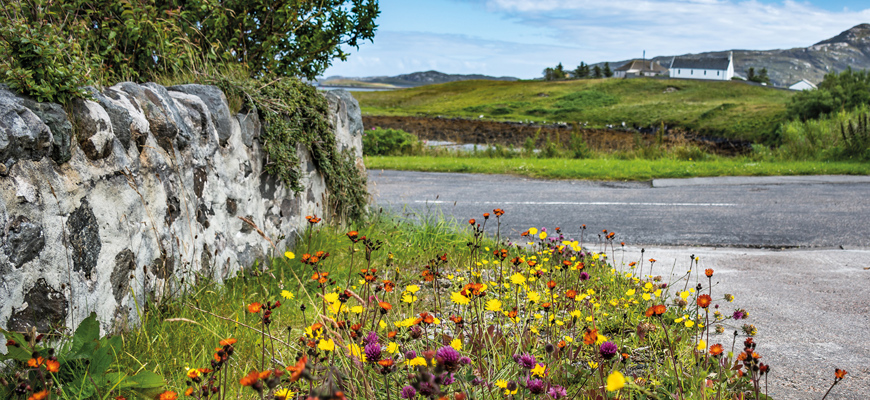Planning by nature

The Scottish Government has announced, following the adoption of our fourth National Planning Framework (NPF4) in February 2023, that an adapted version of Natural England’s Biodiversity Metric 4.0 will be used to support the delivery of biodiversity net gain (“BNG”) as part of all significant development proposals in Scotland. In this article, I consider how the biodiversity metric is designed to work in practice and explore how it might be adapted for use in Scotland. But first, it is important to understand why BNG matters and how the means of achieving it through the development planning process differ north and south of the border.
The state of nature
 The State of Nature Report 2023, published by the UK State of Nature Partnership, lays bare the seriousness of Scotland’s biodiversity crisis. With one in nine species facing the threat of extinction and the abundance of 407 terrestrial and freshwater species decreasing across the country by 15% on average since 1994, Scotland is regarded as a “highly nature-depleted country”. The potential repercussions of this extend beyond immediate ecological concerns: essential resources such as food, building materials and medicines are derived from a variety of plants, animals and other organisms, and their decline puts human health and economic stability at risk.
The State of Nature Report 2023, published by the UK State of Nature Partnership, lays bare the seriousness of Scotland’s biodiversity crisis. With one in nine species facing the threat of extinction and the abundance of 407 terrestrial and freshwater species decreasing across the country by 15% on average since 1994, Scotland is regarded as a “highly nature-depleted country”. The potential repercussions of this extend beyond immediate ecological concerns: essential resources such as food, building materials and medicines are derived from a variety of plants, animals and other organisms, and their decline puts human health and economic stability at risk.
NPF4 gives Scotland’s planning system a crucial role in reversing this crisis, with NPF4 policy 3a in particular requiring planning authorities across Scotland to seek to ensure that all proposals (other than those involving individual household development) “contribute to the enhancement of biodiversity, including where relevant, restoring degraded habitats and building and strengthening nature networks and the connections between them”.
How can BNG help?
BNG aims to ensure that development delivers a quantifiable increase in biodiversity in a given area. The idea is that when development takes place, it should result in a net positive effect on biodiversity compared to the baseline pre-development state. This does not mean the development cannot result in any loss of biodiversity, but that any losses should be outweighed by gains in biodiversity elsewhere, either onsite or offsite. In practical terms, developers or landowners are expected to measure the existing baseline on a site before development occurs. They then implement measures as part of the overall development that are designed to enhance existing or create new habitats to the measured baseline position. This concept, also referred to as “additionality”, is key. Mitigation of adverse effects is no longer enough.
Measures employed are varied and include planting native vegetation, creating wildlife habitats, or restoring ecosystems. Quantification is also key: the overall goal is to leave the natural environment in a measurably better state than it was in before the development was implemented.
The Scottish approach: broad brush
Prior to the adoption of NPF4, Scotland’s planning system focused on avoiding, minimising, restoring or offsetting negative impacts of development (an approach referred to as “the mitigation hierarchy”), rather than leaving nature in a better state. In practice that meant efforts to enhance biodiversity were treated as “desirable” rather than an essential requirement of development. NPF4 policy 3a now makes it a policy requirement that such efforts are applied so far as reasonably practicable at the design stage.
More stringent efforts are expected from the promoters of national and major development projects (i.e. larger scale projects). NPF4 policy 3b provides that proposals involving these categories of development should only be supported by a planning authority where it can be demonstrated by the applicant that the proposal will deliver “significant enhancements” to biodiversity within a reasonable timescale and with reasonable certainty. Appropriate management arrangements for the “long-term” retention and monitoring of the proposed enhancements are also expected to be provided.
There is no guidance as yet from the Scottish Government on what is to be regarded by planning authorities as a “significant” enhancement, or for how long they should expect a “long-term” maintenance arrangement to last – matters which have potentially significant on-costs for developers. Nor is there, as yet, any nationally accepted methodology for quantifying or measuring BNG. This has resulted in a degree of uncertainty among developers, their consultants and Scottish local planning authorities as regards what precisely they are expected to do at the development management stage to ensure that the new national policy requirements in relation to biodiversity are met.
The English approach: prescriptive
England has taken a much more prescriptive approach. From January 2023, pursuant to s 6 of the Environment Act 2021, all new planning permissions granted in England (with a few exemptions) have to deliver at least 10% BNG to ensure that development leaves the natural environment in a measurably better state. Developers are required to carry out a pre-development baseline assessment of the application site and then provide sufficient new habitat creation (preferably onsite), demonstrating how the minimum statutory BNG additionality will be achieved.
To assist that assessment, Natural England has developed the biodiversity metric, a biodiversity accounting tool which quantifies pre- and post-development biodiversity losses and gains in order to calculate BNG. It applies a habitat-based approach that assesses an area’s existing value to wildlife, using habitat features to calculate its biodiversity value. It considers the site, quality, location, distinctiveness and condition of the existing land and intertidal habitats, including hedgerows, rivers and streams. Each type of habitat is given a score; the developer will be required to identify how a 10% increase on the score can be achieved and incorporate that into the development. The tool relies on a competent person (an ecologist, rather than a lawyer) to assess the extent, condition and distinctiveness of current habitats, while maintaining a transparent user-friendly interface. The interface allows developers and planners to explore different scenarios, and in doing so drives innovation in meeting BNG.
The UK Government’s clear preference is that the net gain is achieved onsite, although mechanisms allow the gain to be achieved offsite if necessary. Developers should, in the following order:
- Avoid or reduce biodiversity impacts through site selection and layout.
- Enhance and restore biodiversity onsite, such as by sowing wildflowers along road verges or managing grassland within a housing development to support wildlife.
- If onsite measures are insufficient, use biodiversity “units” from ecological improvements elsewhere, ensuring the replacement habitat is of equal or greater conservation value than the development site. Some units may be obtained from the emerging “net-gain market”, where land managers create units resulting from conservation actions (referred to as “habitat banks”) and sell them to developers. Alternatively, developers can establish their own habitat banks, generating biodiversity units in one location to offset impacts elsewhere. These sites will be bound by a planning obligation or conservation covenant (similar to conservation burdens in Scotland) which requires habitat enhancement works to be carried out on the land and maintained for at least 30 years following completion. Such sites must be registered on a biodiversity gain site register. The habitat enhancement may be allocated to one or more developments in accordance with the terms of the obligation or covenant. Landowners with sites which would benefit from habitat enhancements can work with developers seeking to achieve the BNG objective offsite.
- As a last resort, purchase statutory biodiversity credits from the UK Government, which will be priced higher than the open market cost of biodiversity units.
The guiding principles of England’s BNG policy therefore align with Scotland’s commitment to deliver positive effects for biodiversity, albeit statutory requirements for 10% BNG linked to frameworks for the purchase of Government credits will not apply here.
Issues for a Scottish biodiversity metric
The Scottish Government’s decision to commission NatureScot to adapt Natural England’s biodiversity metric follows the recommendations of a report titled Research into Approaches to Measuring Biodiversity in Scotland, published in September this year as part of the NPF4 delivery programme. It found that with refinement, Natural England’s biodiversity metric is largely applicable for use in the planning sector in Scotland, and several companies are using adapted versions in Scotland to account for biodiversity during site development.
The report underscores the distinctive land cover in Scotland compared to much of the rest of the UK. While over half of England, Wales and Northern Ireland consist of pastures and arable land, Scotland is characterised by peat bogs, moorland and forests, presenting both challenges and opportunities.
One significant challenge identified by the renewable energy sector involves achieving BNG for projects affecting bog habitats, such as upland wind farm projects. Blanket bog, listed as an “irreplaceable” habitat in Natural England’s metric, holds high value and its loss cannot be offset. However, practical considerations, including the nature of the impact, the condition of the blanket bog, and the broader environmental context, may influence whether certain areas are deemed irreplaceable. In Scotland, there is a need for more discussion and guidance on approaching impacts to bog habitats concerning BNG, to establish a transparent and effective way forward.
Whatever form it takes, Scotland’s new biodiversity metric is unlikely to satisfy all stakeholders. The English model has faced criticism for not adequately considering factors beyond habitat, with some arguing it is overly subjective, that it neglects the value of transitional habitats (such as early succession scrub evolving into mixed woodland), and lacks a connection with species of conservation concern.
Striking the right balance between simplicity and complexity is a difficult task. Currently, there is no single metric that encompasses all factors relevant to BNG. Metrics commonly overlook socially important species, red list status, and genetic diversity. At the local level, it could become challenging, if not impossible, to assess the effectiveness of mitigation or intervention, resulting in the continued implementation of potentially ineffective actions without a robust evidence base. Despite these challenges, the report warns against delaying implementation in pursuit of a perfect solution, owing to the urgent need for an aid to decision making under policy 3b.
 On a positive note, the abundance of semi-natural habitats in Scotland offers a greater opportunity than in other parts of the UK for large-scale habitat enhancement and creation. As in England, landowners in Scotland can leverage the biodiversity metric to establish habitat banks. This involves providing developers in their local planning authority with high-integrity habitat units in exchange for a favourable financial return. Given the lower population density and scale of development in Scotland, those representing landowners should make them aware of this prospect before the market becomes saturated with an oversupply.
On a positive note, the abundance of semi-natural habitats in Scotland offers a greater opportunity than in other parts of the UK for large-scale habitat enhancement and creation. As in England, landowners in Scotland can leverage the biodiversity metric to establish habitat banks. This involves providing developers in their local planning authority with high-integrity habitat units in exchange for a favourable financial return. Given the lower population density and scale of development in Scotland, those representing landowners should make them aware of this prospect before the market becomes saturated with an oversupply.
STOP PRESS
On 30 November the Scottish Government published Draft Planning Guidance: Biodiversity.
Regulars
Perspectives
Features
Briefings
- Criminal court: Boundaries of corroboration
- Corporate: Deceptive digital design – no clever cookie?
- Agriculture: Ending LDTs in a second short continuation
- Succession: Attorney as executor?
- Sport: Is that in the rules?
- Scottish Solicitors' Discipline Tribunal: December 2023
- In-house: The real deal
- Intellectual property: Making your mark with a sound






